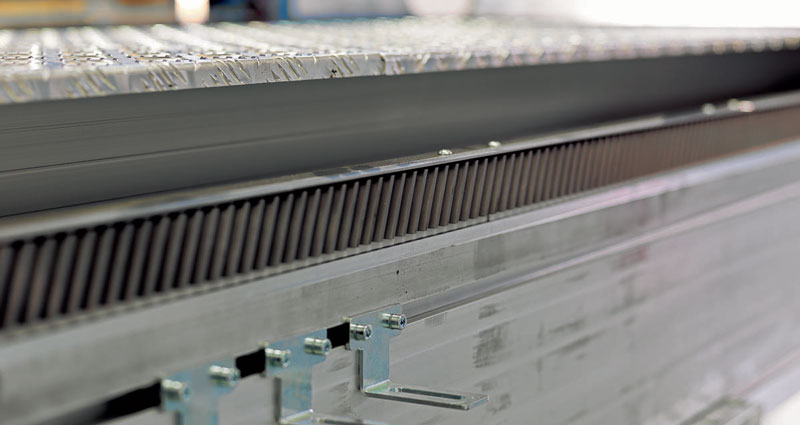Robots Travel on Aluminum
Rollon’s Seventh Axis shuttle system has been developed for handling robots and heavy loads over long distances and with high dynamics. The series is made of aluminum, a material chosen for its lightness and malleability, and because it is not affected by humidity.
by Aldo Biasotto
The anthropomorphic robot market grows year after year in numerous applications, and together with it the need to expand the robot’s range of action with the use of a seventh axis. The possibility of moving the robot along a new axis makes it possible to increase its productivity and efficiency; this is why Rollon has developed a shuttle system, suitable for working with anthropomorphic robots by different manufacturers up to loads of 2,000 kg: the Seventh Axis series.
The Rollon range is made with extruded aluminum profiles, assembled with connection crosspieces designed to give the system maximum rigidity, with recirculating ball guides and rack-and-pinion drives with inclined teeth or toothed belt.

Advantages of aluminum: lightness and flexibility
Aluminum is the distinctive feature of the Rollon offer, in a market where many solutions are made of steel. The latter undoubtedly offers greater mechanical strength in itself, but aluminum, which is extremely malleable and flexible, thanks to the extrusion process can be used to compose extremely elaborate geometries, excellent to guarantee both the greatest moment of inertia and the lowest possible weight. The wire drawing of steel, on the other hand, and in general its processing, does not make it possible to achieve enough complexity to guarantee comparable results. In this way, the seventh aluminum axes quickly regain their way on steel solutions in terms of load capacity, but with an important extra advantage: they are two and a half times lighter.
A light seventh axis offers numerous application advantages, starting with the reduction of transport costs. In addition, the assembly of a solution with almost a third of the weight compared to the steel one is inevitably easier and faster and, above all, safer. Finally, lightness is an important competitive advantage in all those applications that do not include a seventh axis ground mounting, but a ceiling or wall mounting. In these cases, an additional heavy seventh steel axis must not be added to the weight of the robot. The ceiling or wall configuration is very common in applications for painting or welding, in automotive and other industrial sectors.

No alteration for humidity
Steel in its most common form, therefore carbon steel, corrodes on contact with water or in a humid environment. For this reason, steel solutions intended for harsh environments require surface treatments to confer corrosion resistance. These treatments offer different degrees of resistance and naturally affect the cost of the finished solution and delivery time.
Aluminum, as it oxidizes naturally on contact with air, does not undergo any alteration in case of humidity: it is resistant to corrosion and does not require any further treatment in this sense. A simple neutral anodization with pure aesthetic purposes is commonly made.
A completely closed unit
Thanks to the malleability of aluminum, it is possible to create different geometries by extrusion. Particularly functional is the so-called “C” geometry, which provides a square profile with an opening where it is possible to slide the belt and the carriage, making possible to drown the guide inside the profile itself.
The end result is a completely closed unit that contains all the system components: this solution is particularly interesting when there is the need to isolate the seventh axis from the environment (in the presence of dust, liquids or other contaminants) or, on the contrary, when you want to isolate the environment from the seventh axis in case of applications in a clean room or in a sterile environment, where it is necessary to avoid the dispersion of particles. Obviously, such complex machining is not possible with the wire drawing process envisaged in steel processing.

